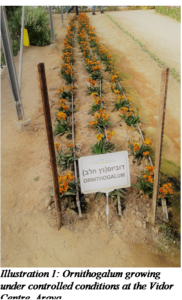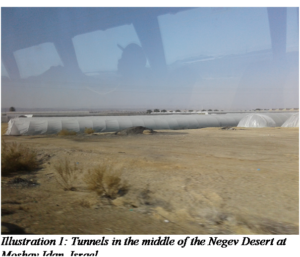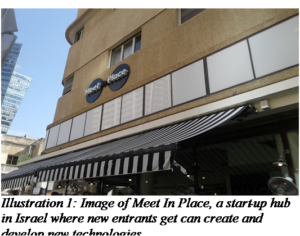Introduction
Still on the hangover from one trip to Israel, on one of my micro-blog posts a comment read: ‘You know, there is a Hebrew saying: a Jew will thrive even when you put (them) in a desert…’. The moment from watching short video clips of the stories of how some of the projects began then rang and I wondered: could it be there was an entire process including curiosity, being progressive, pragmatic and decisive?

The southern parts of Israel are very dry and introduce for the most part harsh conditions for most living organisms. On the contrary, the research and commercial farming in the area of the country are impressive. The use of drip irrigation and greenhouses makes it possible, together with the desalination of the salty lakes in the ground water in the area. Cherry tomatoes are actually sweet as a result of the plant’s need to compensate for the high salt content of the soil. Also, there is a botanical site at Ein Gedi with most plants from the around the world, and the farming community there has got a Baobab which has been planted since 1985.
The Moshavim (Israelis reading this would have to pardon my over-simplification), or commercially motivated farming communities, have figured out how to make the most of the limited resources to maximize on what they have to offer and run commercially successful farms with export potential.
A Kibbutz, is different to a Moshav in that the collective shares the wealth created from the activities of the farming community they form a part of.

Why be decisive?
The two communities, Kibbutzim and Moshavim, are quite different in terms of how they live. However, I have a point to discuss briefly regarding their similarities.
Decisiveness is a factor in most of the progress of these communities. One may say, this is evident from the onset of the decision to farm in a desert for starters. Logically, one would decide to move to where the fruit hang lower (arable land, close water supplies, etc). What is fascinating however, is that from an organizational perspective, it might be that the decision making process that had come with every iteration to eventually get the formula right must have been tormenting. The first attempt to introduce water services must have been tolling both on mind and muscle in the beginning. However, having a vision counted more, and the one person believing in it had a following at each turn. The rest is history because today bell peppers can be farmed to have various colors.

A start-up is a faith based organization for the most part, and most start-up founders and venture capitalists who have followed lean start-up methodology, and have successfully launched businesses, including at a global scale; will often mention these points:
- Rather look at developing a business model instead of the traditional business plan. This often seems to be able to allow for iterating and pivoting whereas a business plan makes assumptions which can often lead to massive blows when the assumptions hold untrue later on. The business model allows for lean resource use whereas a business plan tends to be costly when effected.
- A market is often established upon receiving a number of early adopters, and these individuals tend to influence getting customers and help evangelise a value proposition of a start-up
The situation down here has a different feel:
- Start-up ideas are often good because the region gives entrepreneurs real problems faced by developing countries.
- Money is not always available, and some parts of the world do not have a start-up culture and are in remote areas where access to information may be limited. It is sometimes challenging to get in touch with angel investors or venture capitalists. The market is far too small to sustain high-growth start-ups in some sectors, like ICT.
- Higher education institutions are getting on the programme and are making moves to introduce entrepreneurship education in their respective environments, and the state is actively involving itself in the culmination of events as they unfold, in respect of entrepreneurship development.
- In light of 4. above, introducing entrepreneurship education in higher education institutions is a positive move, however, there might still be a need to access rural communities while observing the fact that with most educated class persons a migration to developed areas in developing countries tends to happen with the flow directed towards metropolitan areas (local brain drain). This parallel to the immigration of skilled persons from developing countries to developed countries (global brain drain).
- There are still issues around responsible resource use. To an extent, the challenges posed both by nature (the usual, hail, veld fires, recurring flooding and drought, tropical storms) and by man are (erecting structures that fail to fulfill their design purpose, poor workmanship during construction, unmaintained infrastructure, etc) can be looked towards for entrepreneurial exploration because these pose challenges which may be looked at as either crises or opportunities, as in 1, above.

Farming communities have been established in the harshest possible environments where the practicality seems daunting. However, having passion for solutions to challenges and actually overcoming them is quite an interesting occurrence to witness.
There are signs of a decision making in as far as macro-scale decision makers are involved and concerned. On the part of the aspiring entrepreneur, they are faced with the decision to enter an unknown market with either a model or a plan, and existing platforms while access to resources is limited, although it is not all bad: there are signs of positive displacement. It may be necessary for start-ups to realise the importance of iterating the processes involved in business development just as real time cases are demonstrating, and have been for a some time, the opportunities that come with a little pragmatism, progressive thinking and decision making based in iterating. There are techniques which have been used by leading entrepreneurs and the rewards have made a mark in the books of history.
Start-ups, small micro- and medium enterprises, and medium to large enterprizes of short to medium duration life cycles are necessary interventions to the challenges of job-creation and more importantly, bridging the gap between large markets accessible to very large corporations. However, start-ups need to begin very small, with a limited number of co-founders, often of high end skills, who may or may not have a disconnect with the local, rural markets. To some extent, this may need to be looked at from the perspectives of being pragmatic (looking at what is feasible), decisive (what needs to be done), and progressive (how is every stakeholder going to equitably gain while mitigating relations with the immediate environment, including in built environments).

Closure
Perhaps many of our challenges locally can be addressed after all, given the many opportunities (read crises) availed to us by circumstance?
